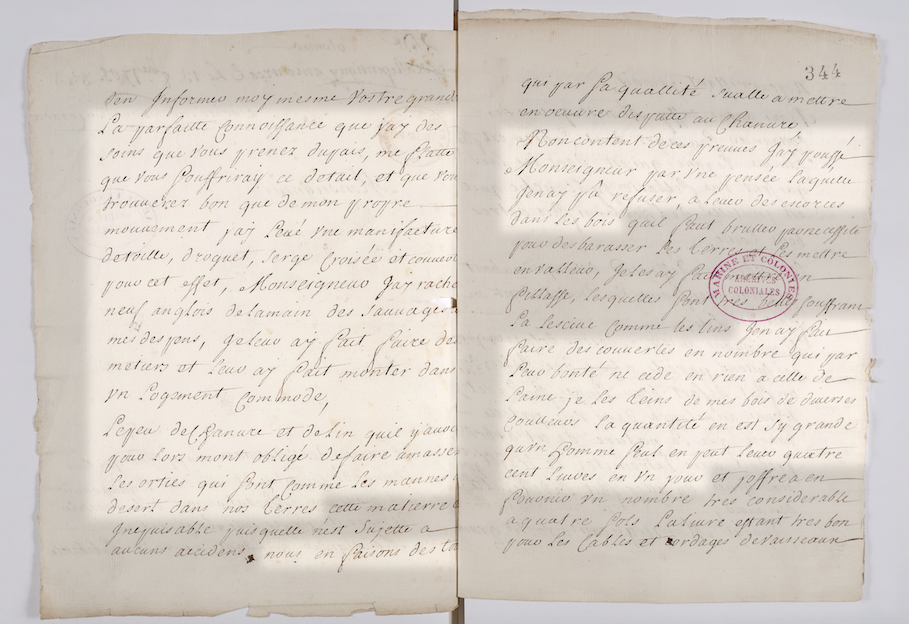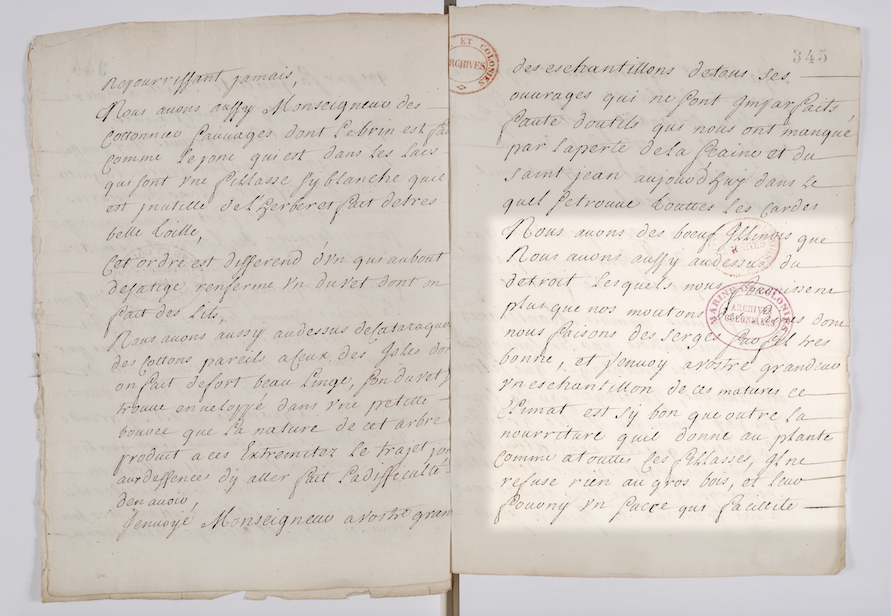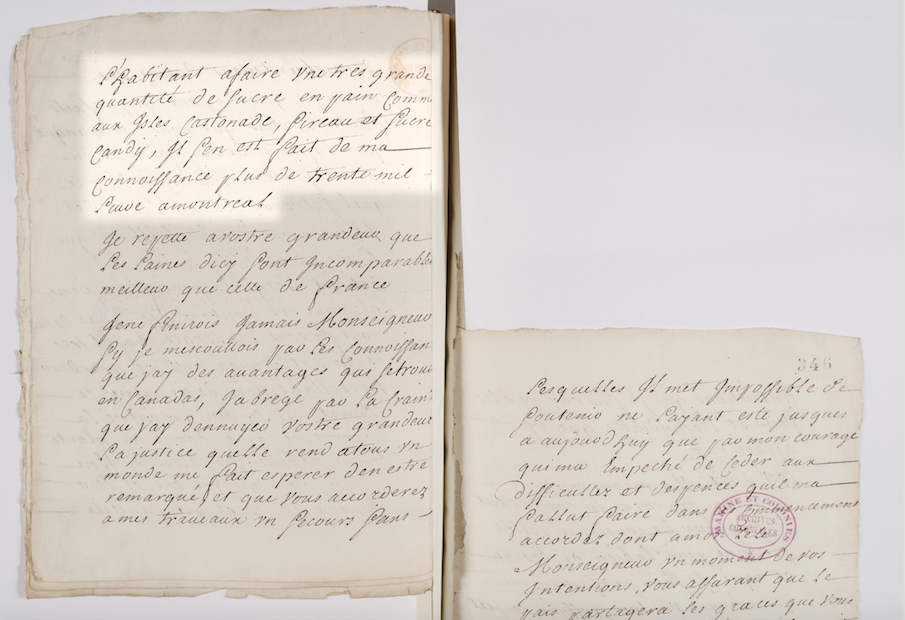Letter from Agathe de Saint-Père de Legardeur de Repentigny to the Minister of Marine and Colonies
Document
Image
Video
Audio
 Activities
Activities
LOOK
Listen to, or read, the excerpt from Agathe de Saint-Père’s letter. What are its key messages?
THINK
Listen to, or read, the excerpt from Agathe de Saint-Père’s letter. Are there any parts you don’t understand, or have questions about? Make a list of your questions, and do a bit of research to find the answers.
THINK
To understand people from the past, we need to look at their “historical perspective.” Take the perspective of Agathe de Saint-Père, for example. What would a woman need in order to start a textile business during the 18th century? Based on what you know about New France, what are some of the challenges she might have faced?
THINK
To understand people from the past, we need to look at their “historical perspective.” After reading, or listening to this letter and the historical information provided, make a list of the different people, or groups of people, mentioned (e.g., Agathe de Saint-Père, the Minister of Marine and Colonies, etc.). Are there others, not mentioned in the letter, whose perspectives might add to our understanding of people of New France?
Details
 Materials
Materials - Paper
Transcript
Knowing full well your interest in this country, I am flattered that you wish to hear the details of my business endeavours and that you will be pleased to read about how I have single-handedly established a factory making linen, drugget, twill serge, and blankets. For this, I ransomed nine English men from their Indian captors at my own expense. I had looms built for them and have put them up in suitable quarters. The shortage of hemp and flax has forced me to gather nettles, which abound in our land. From it, we make a canvas. Not satisfied with these results, I was impelled, my Lord, by a thought I couldn’t ignore: to collect bark in the woods. From it, I have made numerous blankets that are as good as wool. I dye them using woods of various colours. The bark is so plentiful that a single man can gather 400 lbs of it in a day. We also have Illinois cattle that we find north of Detroit, and which yield more wool than our sheep. From this wool, we make strong serge thread. I enclose for you, my Lord, a sample of this material.
The climate here is so good that it nourishes not only textile crops but also large trees. It imbues these trees with a sugar which the habitants collect to make sugar loaf, as in the Caribbean Islands. Brown sugar, syrup and sugar candy. To my knowledge, they make more than 30,000 lbs of it around Montréal.
Historical Context
Choose one of the three levels below to match your needs.
- This letter was written by Agathe de Saint-Père, a woman who owned a textile business in New France.
- Because she couldn’t get the materials she normally used, she used local materials like bison wool and milkweed.
- She was probably inspired by Indigenous Peoples who wove with these types of materials.
- In her letter, she also talks about collecting maple sap to make maple syrup, which the people of New France learned from Indigenous Peoples.
This letter was written by Agathe de Saint-Père to the Minister of Marine and Colonies of France in 1705. In it, she describes her textile business and the different materials that she and her employees use.
Agathe describes using locally available materials such as nettles, bark, milkweed and bison wool to make blankets. She also notes that maple sap can be collected from trees to make maple syrup and sweeteners. It’s likely that she learned these practices from the local Indigenous communities, although she doesn’t say so in her letter.
This letter was written by Agathe de Saint-Père to the Minister of Marine and Colonies of France in 1705. In it, she describes her textile business and the different materials that she and her employees used.
Due to a shortage of flax and hemp, Agathe describes using locally available materials such as nettles, bark, milkweed and bison wool to make blankets. Although she does not mention them in her letter, it’s likely that she was inspired by Indigenous Peoples, who used these same materials.
Agathe de Saint-Père writes that the climate in New France “imbues … trees with sugar which the habitants collect.” She is referring to the maple sap used to make maple syrup and other sweeteners. This practice was also learned from the Indigenous communities in the area.
- This letter was written by Agathe de Saint-Père, a woman who owned a textile business in New France.
- Because she couldn’t get the materials she normally used, she used local materials like bison wool and milkweed.
- She was probably inspired by Indigenous Peoples who wove with these types of materials.
- In her letter, she also talks about collecting maple sap to make maple syrup, which the people of New France learned from Indigenous Peoples.
This letter was written by Agathe de Saint-Père to the Minister of Marine and Colonies of France in 1705. In it, she describes her textile business and the different materials that she and her employees use.
Agathe describes using locally available materials such as nettles, bark, milkweed and bison wool to make blankets. She also notes that maple sap can be collected from trees to make maple syrup and sweeteners. It’s likely that she learned these practices from the local Indigenous communities, although she doesn’t say so in her letter.
This letter was written by Agathe de Saint-Père to the Minister of Marine and Colonies of France in 1705. In it, she describes her textile business and the different materials that she and her employees used.
Due to a shortage of flax and hemp, Agathe describes using locally available materials such as nettles, bark, milkweed and bison wool to make blankets. Although she does not mention them in her letter, it’s likely that she was inspired by Indigenous Peoples, who used these same materials.
Agathe de Saint-Père writes that the climate in New France “imbues … trees with sugar which the habitants collect.” She is referring to the maple sap used to make maple syrup and other sweeteners. This practice was also learned from the Indigenous communities in the area.
Summary
- This letter was written by Agathe de Saint-Père, a woman who owned a textile business in New France.
- Because she couldn’t get the materials she normally used, she used local materials like bison wool and milkweed.
- She was probably inspired by Indigenous Peoples who wove with these types of materials.
- In her letter, she also talks about collecting maple sap to make maple syrup, which the people of New France learned from Indigenous Peoples.
Essential
This letter was written by Agathe de Saint-Père to the Minister of Marine and Colonies of France in 1705. In it, she describes her textile business and the different materials that she and her employees use.
Agathe describes using locally available materials such as nettles, bark, milkweed and bison wool to make blankets. She also notes that maple sap can be collected from trees to make maple syrup and sweeteners. It’s likely that she learned these practices from the local Indigenous communities, although she doesn’t say so in her letter.
In-Depth
This letter was written by Agathe de Saint-Père to the Minister of Marine and Colonies of France in 1705. In it, she describes her textile business and the different materials that she and her employees used.
Due to a shortage of flax and hemp, Agathe describes using locally available materials such as nettles, bark, milkweed and bison wool to make blankets. Although she does not mention them in her letter, it’s likely that she was inspired by Indigenous Peoples, who used these same materials.
Agathe de Saint-Père writes that the climate in New France “imbues … trees with sugar which the habitants collect.” She is referring to the maple sap used to make maple syrup and other sweeteners. This practice was also learned from the Indigenous communities in the area.




